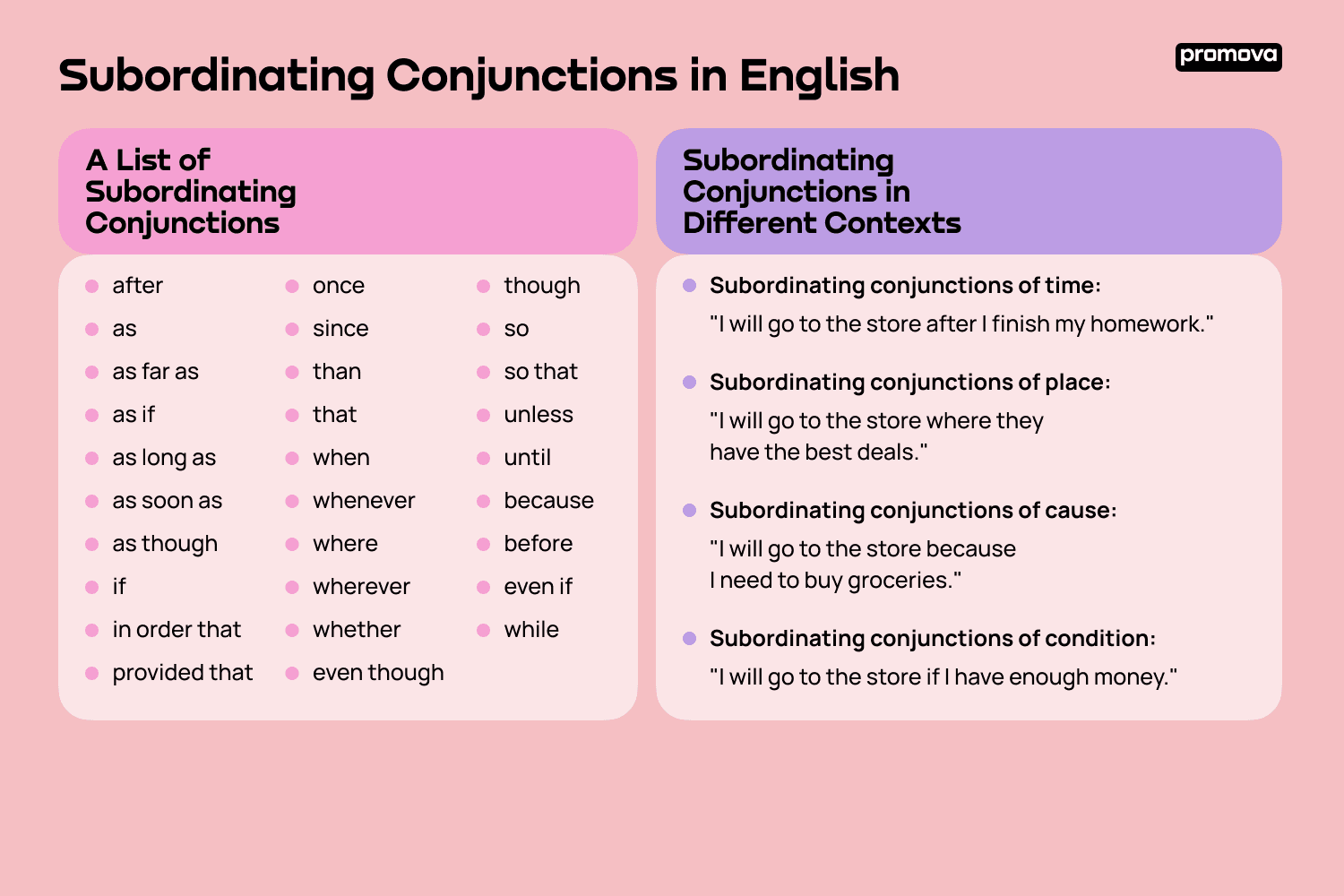Subordinating Conjunctions in English
Contents
In this reference, we'll discuss what a subordinating conjunction is, the different types of subordinating conjunctions, how to use them in sentences, and some common mistakes learners often make with this part of speech. Let's start learning!
What is a Subordinating Conjunction?
Subordinating conjunctions are words or phrases that join two or more clauses together. It introduces a dependent clause and indicates the relationship between the two clauses. These conjunctions are used to indicate the logical relationship between clauses. Subordinating conjunctions can also be used to indicate time, place, or cause.
Subordinating conjunctions are also known as dependent-clause markers or subordinate conjunctions. They are usually placed at the beginning of a dependent clause, and they can be used to show the relationship between the main clause and the subordinate clause.
For example, in the sentence "I will go to the store after I finish my homework," the subordinating conjunction "after" is used to indicate the relationship between the two clauses. It indicates that the action in the main clause (going to the store) will happen after the action in the subordinate clause (finishing homework).

Different Types of Subordinating Conjunctions
There are many different types of subordinating conjunctions, and they can each be used to indicate a different relationship between two clauses.
- Subordinating conjunctions of time: These conjunctions are used to indicate when something happens. Examples include: after, before, when, while, since, until, as soon as, as long as, etc.
- Subordinating conjunctions of place: These conjunctions are used to indicate where something happens. Examples include: where, wherever, wherever, wherever, etc.
- Subordinating conjunctions of cause: These conjunctions are used to indicate why something happens. Examples include: because, since, so that, in order that, etc.
- Subordinating conjunctions of condition: These conjunctions are used to indicate a condition that must be met in order for something to happen. Examples include: if, unless, whether, even if, etc.
Examples of Subordinating Conjunctions in sentences
Subordinating conjunctions are often used in sentences to show the relationship between two clauses.
"I will go to the store after I finish my homework."
Here, "after" is used to indicate that the action in the main clause (going to the store) will happen after the action in the subordinate clause (finishing homework).
"I will go to the store if I have enough money."
Here, "if" is used to indicate that the action in the main clause (going to the store) will only happen if the condition in the subordinate clause (having enough money) is met.
"I will go to the store where they have the best deals."
Here, "where" is used to indicate the location of the action in the main clause (going to the store).
8
Rules for Using Subordinating Conjunctions
When using subordinating conjunctions, it is important to remember the following rules:
- The dependent clause must come first and the independent clause must come second.
- The subordinating conjunction must be followed by a subject and a verb.
- The dependent clause must be placed as close as possible to the independent clause.
- The dependent clause must not be separated from the independent clause by a comma.
- The dependent clause must not be placed in the middle of the sentence.
Subordinating Conjunctions in Different Contexts
Subordinating conjunctions can be used in different contexts to indicate the relationship between two clauses. Here are some examples of subordinating conjunctions in different contexts:
- Subordinating conjunctions of time: "I will go to the store after I finish my homework."
- Subordinating conjunctions of place: "I will go to the store where they have the best deals."
- Subordinating conjunctions of cause: "I will go to the store because I need to buy groceries."
- Subordinating conjunctions of condition: "I will go to the store if I have enough money."
A List of Subordinating Conjunctions
Commonly used subordinating conjunctions:
- after
- as
- as far as
- as if
- as long as
- as soon as
- as though
- if
- in order that
- once
- provided that
- since
- than
- that
- when
- whenever
- where
- wherever
- whether
- while
- though
- so
- so that
- unless
- until
- because
- before
- even if
- even though
Common Mistakes with Subordinating Conjunctions
When using subordinating conjunctions, it is important to remember the rules for using them.
- Placing the dependent clause in the middle of the sentence: This is incorrect because the dependent clause must come first and the independent clause must come second.
- Placing a comma between the two clauses: This is incorrect because the dependent clause must not be separated from the independent clause by a comma.
- Not following the subordinating conjunction with a subject and a verb: This is incorrect because the subordinating conjunction must be followed by a subject and a verb.
Summary
Subordinating conjunctions can be used to indicate the logical relationship between two clauses, as well as to indicate time, place, or cause. Once you know the rules for using them in sentences, you can make your language sound more fluid and natural. Check out more handy references to learn more!
Comments